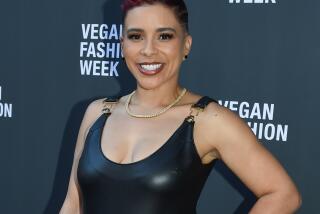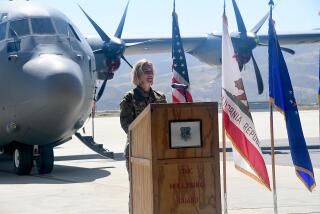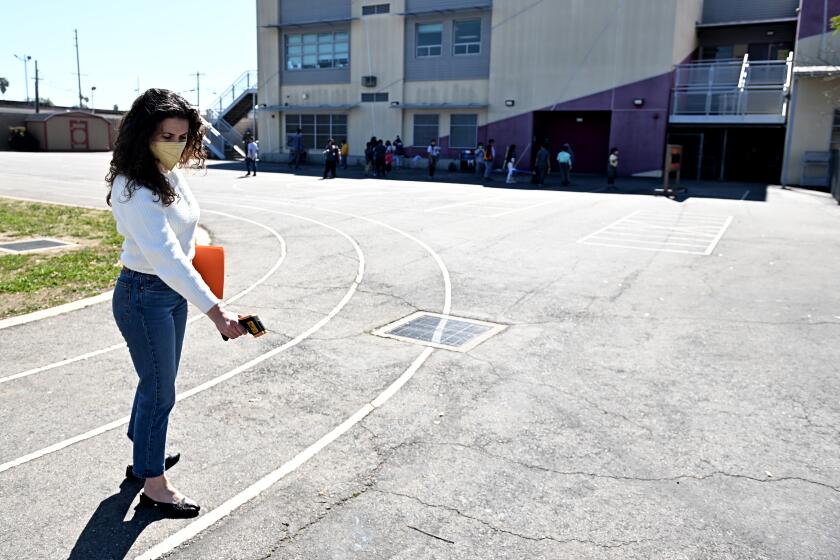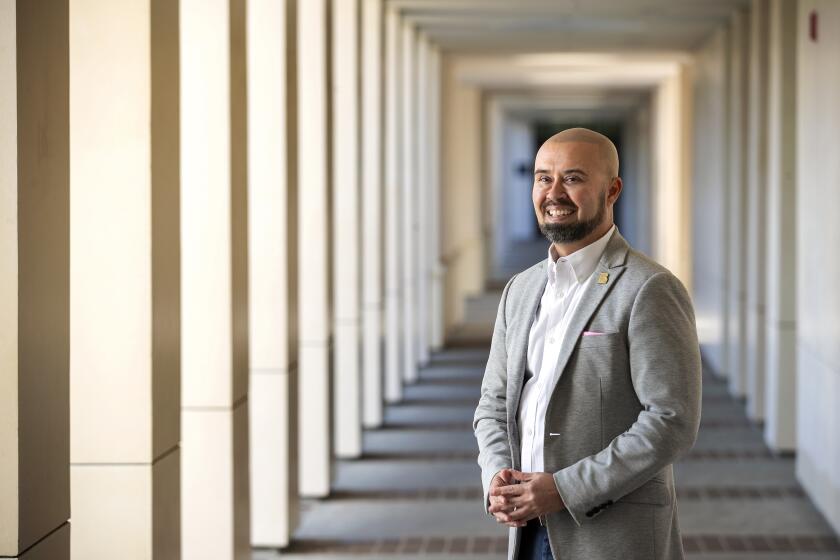Showdown for a Reputed Mobster : Crime: Michael Rizzitello has has various troubles with the law over the years but has served little time. Today, however, he will go on trial on charges of attempting to kill a rival for profits from a topless bar.
“The gun and the knife. . . them are the tools by which you live and die.”
--Jimmy Fratianno, at Michael Anthony Rizzitello’s initiation as a “made guy” into La Costa Nostra, 1976.
For reputed top racketeer Michael Anthony Rizzitello, jails and courtrooms have been familiar turf in his autumn years. He has been arrested nine times in the past 13 years and spent nearly half of that time behind bars.
But despite all his arrests, the 62-year-old Rizzitello, who authorities claim is a capo (underboss) in the Milano crime family of Los Angeles, has eluded any serious prison time. The last three times he was on trial, he was acquitted.
But now, in a case that has drawn interest nationwide from organized crime fighters, Rizzitello faces his most serious trouble. He is accused of shooting a Santa Ana night club figure in 1987 during a mob-style attempt to cut in on the topless bar’s profits. If convicted, Rizzitello could very well die in prison--the penalty would be an automatic 30 years to life.
Testimony at Rizzitello’s trial is scheduled to begin today, after opening statements, before Superior Court Judge John L. Flynn Jr.
“It’s a tough case,” acknowledged Rizzitello’s attorney, Anthony P. Brooklier.
The victim, William Carroll, though left permanently blind, survived three shots to the back of his head and named Rizzitello as his assailant. Joey Grosso, already convicted as a participant, also names Rizzitello as the gunman.
His lawyer asserts that Rizzitello may be on trial simply because organized crime authorities have been after him for so long.
“Mike Rizzitello is a trophy for them,” Brooklier said. “They want him so bad, they’re going after him no matter what. They’re bitter about those last three acquittals.”
Prosecutors scoff at such accusations. But law enforcement officials who specialize in organized crime anxiously await the outcome of Rizzitello’s trial.
“This trial will be the E-Ticket,” one official said.
Though the aging mobster steadfastly claims he is innocent, he is known as a gunman within organized crime.
Deputy Dist. Atty. Christopher J. Evans has called him in court papers “a professional killer.”
Federal prosecutor William M. Elsburg bluntly said of Rizzitello and another racketeer in court papers for a previous trial: “They are bad people who like to associate with bad people.”
Rizzitello--known as Mike Rizzi--was once one of the few figures with solid racketeering credentials on both coasts.
Prosecutors allege that he started with “Crazy Joe” Gallo, a maverick in one of the New York crime families, in the 1950s. Rizzitello himself writes in bail bond papers that he moved to California in 1956, but other published reports show him with strong ties to the New York rackets in 1960.
In 1962, he was arrested for a string of armed robberies of restaurants and businesses in the Hollywood area and served nine years in prison. It was in 1970, in prison at Chino, that he met William Heldman, who was serving a sentence for grand theft. The two regularly played tennis together on the prison courts. Heldman later changed his last name to Carroll.
Rizzitello’s notoriety grew in “The Last Mafioso,” a 1981 best seller on organized crime written by Ovid DeMaris in cooperation with mob hit man Jimmy (The Weasel) Fratianno. Fratianno became a government witness and testified at two of Rizzitello’s trials.
Fratianno said he first met Rizzitello in 1974 and states in “The Last Mafioso”: “There’s a new guy that’s friendly with Pete (Milano). A big guy, calls himself Mike Rizzi.”
Fratianno claimed that Rizzitello was Gallo’s top gunman. “Remember Tony the Sheik? He told me to stay away from Rizzi because he was going to get whacked (killed). But Rizzi went back East and somehow straightened out the beef.”
Fratianno’s next reference to Rizzitello is a year later. He claims Rizzitello was lamenting that a man who had paid him $50,000 to kill his business partner had been killed himself, ending a source of income. Fratianno claims that he and Rizzitello soon became close.
Fratianno at the time was one of the temporary bosses of the Los Angeles crime family while its leaders were in prison. It was on June 6, 1976, Fratianno states, that Rizzitello was initiated as a member of La Cosa Nostra--”this thing of ours.”
Small Ventures
Rizzitello, at the time, was involved in small business ventures--one with ties to the garment industry, another in business machinery--and lived in Canoga Park with his wife, Terry, their two daughters and a son.
But court records show that Rizzitello remained busy with racketeering activities and had other troubles with law enforcement.
In 1976, he was arrested and convicted of insurance fraud and was subsequently arrested and acquitted of strong-arming an acquaintance over a gambling debt. In 1977, he was arrested in a mail-billing scheme and convicted. He was sentenced to three years for the two convictions.
Time magazine singled out Rizzitello in September, 1977, as “rising quickly in influence and power” in the Los Angeles Cosa Nostra family. It credited him with helping the mob control most of the $100-million-a-year pornography business in the county.
In 1978, Rizzitello and five other leaders of the Milano family were indicted in the biggest racketeering case in Los Angeles history. (One died before the trial).
They were accused of using threats to muscle in on profits of pornographers in the county. One group of pornography dealers turned out to be undercover federal agents. Rizzitello was accused of trying to extort a million dollars from Moe Dalitz, a Las Vegas casino and hotel owner.
Fratianno was a key witness against them. All five were convicted on most of the charges.
“This is the first time the entire hierarchy of a La Cosa Nostra family has been convicted in one case,” a jubilant federal prosecutor, James D. Henderson, said at the time.
In 1981, while Rizzitello was free on appeal, he was sent to New York to stand trial on charges of conspiring with Fratianno to kill a government witness for Pennsylvania crime boss Russell Bufalino. Fratianno was the chief witness. Bufalino was convicted, Rizzitello acquitted.
When the five Milano figures were sentenced in the racketeering case in 1983, prosecutors hoped to put them away for good. But U.S. District Judge Terry J. Hatter Jr. gave them unexpectedly light sentences. Many speculate it was because Hatter considered them small-time hoodlums with no real organization such as crime families have in New York or Chicago.
At his sentencing, Rizzitello discounted claims that he had planned to leave the country while free on bail.
“No matter what happens to me, I wouldn’t leave my wife and my kids,” Rizzitello told the judge.
Hatter sentenced him to five years in prison and told him: “I hope that when you complete your sentence, you will return to your family as a law-abiding citizen.”
But Rizzitello’s trouble with the law continued.
By the time he was released from prison in 1986, he was already on trial again, this time on charges that he and others tried to defraud a Montana firm in a fraudulent transfer of stock. He was acquitted.
In 1987, Rizzitello was back in court, charged with trying to market $1 million in stolen bonds. For the third time since the racketeering convictions, he was acquitted.
But before this acquittal, two significant incidents occurred that would dramatically affect Rizzitello’s future.
Carroll, chief financier for the Mustang Club in Santa Ana, was shot just after midnight on May 1, 1987, in an empty Costa Mesa parking garage. He refused to identify his attacker. A month later, Rizzitello was returned to federal prison for a parole violation--associating with known criminals. He would remain at Terminal Island for the next nine months.
Named His Attackers
In October, 1988, Carroll, after 18 months of silence, named Rizzitello and Grosso as his attackers. Rizzitello has remained in the Orange County Jail since then.
In the Los Angeles racketeering case, prosecutors said the crime family leaders told the pornographers: “We want a piece of your action.” In the Orange County case, prosecutors say, it was the same approach.
Carroll has yet to testify that Rizzitello directly pressured him for profits from the Mustang Club. But prosecutors say Rizzitello was convinced that Carroll would not cooperate, so he decided to eliminate him.
“This is for not letting us eat,” Carroll claims Rizzitello told him just before firing the three shots.
Prosecutors Evans has told the court that the meaning was clear because Mustang Club manager Gene Lesher eventually did give in to Rizzitello’s demands and paid him $5,000 each week through a confederate. Evans argued:
“Mr. Carroll is effectively out of the way. Immediately, (Rizzitello) is in contact with the next person in line to dish out money.”
Lesher testified at Grosso’s trial in November that Rizzitello told him, “Bill Carroll was eating alone. . . you’re involved.”
Brooklier, Rizzitello’s lawyer, would not discuss defense strategy. But he describes Rizzitello as someone who is well liked, often even by his jailers and the judges in his cases.
“Mike is a simple, common man,” said Adam Dawson, an investigator for Brooklier. “With Mike Rizzitello, what you see is what you get.”
More to Read
Start your day right
Sign up for Essential California for news, features and recommendations from the L.A. Times and beyond in your inbox six days a week.
You may occasionally receive promotional content from the Los Angeles Times.





